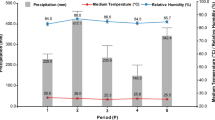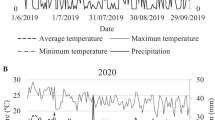Abstract
South American leaf blight (SALB), the most dangerous disease of the rubber tree, is responsible for the lack of significant natural rubber production in South America and is a major threat to rubber tree plantations in Asia and Africa. Although the selection of resistant clones is the preferred disease control method, greater knowledge is required of the relationship between host and pathogen, in order to construct more durable resistance. Based on small-scale trials, this study set out to compare the dynamics of SALB on two highly susceptible and one moderately susceptible clone and to analyse the effect of host phenology on disease severity, at leaflet and flush scales. Clonal resistance was found to have a noticeable effect on disease severity, asexual sporulation and stromatal density at both leaflet and flush levels, and on disease dynamics at a leaflet level; time for symptom and sporulation appearance were longer on the moderately susceptible clone than on the susceptible clones. On the moderately susceptible clone, the stromatal density was largely dependent on disease severity. The phenology did not differ among the three clones and could not be considered as a factor in genetic resistance to SALB. However, for the three clones, the position of the leaflet in the flush affected the duration of the immature stages and the disease: the shorter the duration of leaflet development, the lower the disease severity, the sporulation intensity and the stromatal density.




Similar content being viewed by others
References
Berry, D., & Cilas, C. (1994). Etude génétique de la réaction à la pourriture brune des cabosses chez des cacaoyers (Theobroma cacao L.) issus d’un plan de croisement diallèle. Agronomie, 14, 599–609.
Blasquez, C. H., & Owen, J. H. (1963). Histological studies of Dothidella ulei on susceptible and resistant hevea clones. Phytopathology, 53, 58–65.
Chee, K. H. (1976a). Factors affecting discharge, germination and viability of spores of Microcyclus ulei. Transactions of the British Mycological Society, 66(3), 499–504.
Chee, K. H. (1976b). Assessing susceptibility of Hevea clones to Microcyclus ulei. Annals of Applied Biology, 84, 135–145.
Chee, K. H. (1976c). South American leaf blight of Hevea brasiliensis: Spore dispersal of Microcyclus ulei. Annals of Applied Biology, 8, 147–152.
Chee, K. H. (1985). An analysis of possible preventive measures against the introduction of South American leaf blight to Malaysia. Plant Quarantine Support for Agricultural Development Regional Conference, Kuala Lumpur, December 1985, 261–263.
Darmono, T. W., & Chee, K. H. (1985). Reaction of Hevea clones to races of Microcyclus ulei in Brazil. Journal of the Rubber Research Institute of Malaysia, 33(1), 1–8.
de Araujo, A. E., Kalil Filho, N., Nogrega, M. B. M., Sousa, N. C., & dos Santos, J. W. (2001). Reaçaõ de dez clones de seringueira (Hevea benthamiana) a três isolados de Microcyclus ulei. Acta Amazonica, 31(3), 349–356.
Furtado, E. L. (1990). Comportamento deciduo da seringueira (Hevea spp.) e quantificação do mal das folhas causado por Microcyclus ulei (P. Henn.) v. Arx. Relatorío de Maestrado em Agronomia, Escola Superior de Agricultura Luiz de Queiroz, Universidade de São Paulo, Brazil, 82 pp.
Garcia, D., Cazaux, E., Rivano, F., & d’Auzac, J. (1995). Chemical and structural barriers to Microcyclus ulei, the agent of South American leaf blight, in Hevea spp. European Journal of Forest Pathology, 25, 282–292.
Garcia, D., Mattos, C. R. R., Gonçalves, P. de S., & Le Guen, V. (2004). Selection of rubber clones for resistance to South American leaf blight and latex yield in the germplasm of the Michelin Plantation of Bahia (Brazil). Journal of Rubber Research, 7(3), 188–198.
Guyot, J., Ntawanga Omanda, E., Ndoutoume, A., Mba Otsaghe, A.-A., Enjalric, F., & Ngoua Assoumou, H.-G. (2001). Effect of controlling Colletotrichum leaf fall of rubber trees on epidemic development and rubber production. Crop Protection, 20(7), 581–590.
Hallé, F., & Martin, R. (1968). Etude de la croissance rythmique chez l’hévéa (Hevea brasiliensis Müll.-Arg. Euphorbiacées-Crotonoïdées). Adansonia, série 2, 8(4), 475–503.
Hashim, I., Chee, K. H., & Duncan, E. J. (1978). Reaction of Hevea leaves to infection with Microcyclus ulei. Journal of the Rubber Research Institute of Malaysia, 26(2), 67–75.
Holliday, P. (1970). South American Leaf Blight (Microcyclus ulei) of Hevea brasiliensis. Phytopathological Papers 12, Farnham Royal, CAB, 1–31.
Junqueira, N. T. V., Chaves, G. M., Zambolim, L., Alfenas, A. C., & Gasparotto, L. (1988). Reaçaõ de clones de seringueira a varios isolados de Microcyclus ulei. Pesquisa Agropecuária Brasileira, 23(8), 877–893.
Junqueira, N. T. V., Lieberei, R., Kalil Filho, A. N., & Lima, M. I. P. M. (1990). Components of partial resistance in Hevea clones to rubber tree leaf blight, caused by Microcyclus ulei. Fitopatologia Brasileira, 15(3), 211–214.
Langford, M. H. (1945). South American leaf blight of Hevea rubber trees. Tech. Bull. U.S. Dep. Agric., 882, pp. 31.
Le Guen, V., Garcia, D., Mattos, C. R. R., & Clément-Demange, A. (2002). Evaluation of field resistance to Microcyclus ulei of a collection of Amazonian rubber tree (Hevea brasiliensis) germplasm. Crop Breeding and Applied Biotechnology, 2(1), 141–148.
Lespinasse, D. (1999). Cartographie génétique de l’hévéa (Hevea spp.) et déterminisme de la résistance au champignon pathogène Microcyclus ulei. PhD thesis, Université de Montpellier II, Montpellier, 111 pp.
Mattos, C. R. R., Garcia, D., Pinard, F., & Le Guen, V. (2003). Variabilidade de isolados de Microcyclus ulei no sudeste da Bahia. Fitopatologia Brasileira, 28(5), 502–507.
Medeiros, A. G. (1976). Novos conceitos técnicos sobre contrôle quimico do « mal-das-folhas » da seringueira. Boletim técnico do Centro de Pesquisas do Cacau, Itabuna (Bahia). Brazil, 35, 5–20.
Ortolani, A. A., Pedro Junior, M. J., Alfonsi, R. R., Camargo, M. B. P., & Brunini, O. (1983). Aptido agroclimatica para reginalizacaõ da heveicultura no Brasil. Primeiro seminario brasileiro sobre recomendaçoes de clones de seringueira, Embrapa, Brasilia, 19–28.
Rao, B. S. (1973). South American leaf blight: Chances of introduction and likely behaviour in Asia. Quarterly Journal - Rubber Research Institute of Sri Lanka, 50, 218–222.
Rao, B. S., & Azaldin, M. Y. (1973). Progress towards recommending artificial defoliation for avoiding secondary leaf fall. Proceedings of the Rubber Research Institute, Malaya Planters’ Conference, 267–280.
Rivano, F. (1992). La maladie sud-américaine des feuilles de l’hévéa. Etude, en conditions naturelles et contrôlées, des composants de la résistance partielle de l’hévéa à Microcyclus ulei (P. Henn.) V. Arx. PhD thesis, Université de Paris-sud, Centre d’Orsay, Paris, 218 pp.
Sambugaro, R., Furtado, E. L., Rodella, R. A., & Mattos, C. R. R. (2004). Anatomia foliar de seringueira (Hevea spp.) e desenvolvimento da infeccião por Microcyclus ulei. Summa Phytopathologica, 30(1), 51–56.
Sénéchal, Y. (1986). L’anthracnose des feuilles de l’hévéa, étude épidémiologique et recherche de moyens de lutte. PhD thesis, Université Paris XI, Orsay, 241 pp.
Stahel, G. (1917). De Zuid-Amerikaansche Hevea-Bladziekte veroorzaakt door Melanopsammopsis ulei nov. Gen. (=Dothidella ulei P. Hennings). Surinam Department of Agriculture, Bulletin no. 34, 111 pp.
Acknowledgements
The authors would like to thank the entire team at the Pointe-Combi experimental station for ensuring upkeep of the trials, along with Peter Biggins for the English translation of this article.
Author information
Authors and Affiliations
Corresponding author
Rights and permissions
About this article
Cite this article
Guyot, J., Cilas, C. & Sache, I. Influence of host resistance and phenology on South American leaf blight of the rubber tree with special consideration of temporal dynamics. Eur J Plant Pathol 120, 111–124 (2008). https://doi.org/10.1007/s10658-007-9197-6
Received:
Accepted:
Published:
Issue Date:
DOI: https://doi.org/10.1007/s10658-007-9197-6




